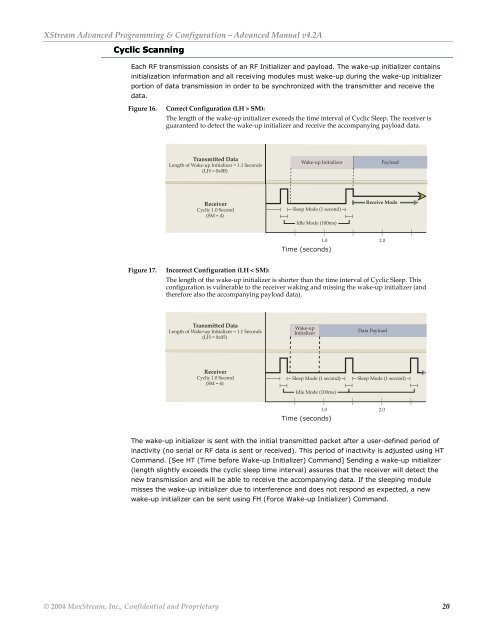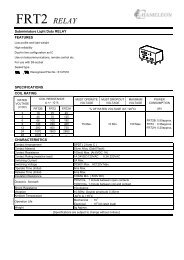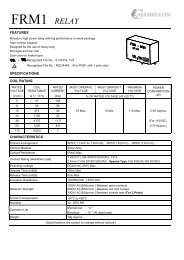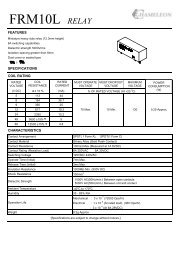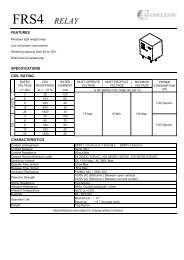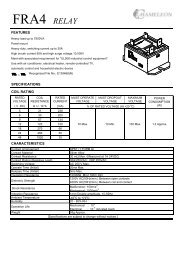XStream⢠Advanced Programming & Configuration
XStream⢠Advanced Programming & Configuration
XStream⢠Advanced Programming & Configuration
Create successful ePaper yourself
Turn your PDF publications into a flip-book with our unique Google optimized e-Paper software.
XStream <strong>Advanced</strong> <strong>Programming</strong> & <strong>Configuration</strong> – <strong>Advanced</strong> Manual v4.2A<br />
Cyclic Scanning<br />
Each RF transmission consists of an RF Initializer and payload. The wake-up initializer contains<br />
initialization information and all receiving modules must wake-up during the wake-up initializer<br />
portion of data transmission in order to be synchronized with the transmitter and receive the<br />
data.<br />
Figure 16.<br />
Correct <strong>Configuration</strong> (LH > SM):<br />
The length of the wake-up initializer exceeds the time interval of Cyclic Sleep. The receiver is<br />
guaranteed to detect the wake-up initializer and receive the accompanying payload data.<br />
Transmitted Data<br />
Length of Wake-up Initializer = 1.1 Seconds<br />
(LH = 0x0B)<br />
Wake-up Initializer<br />
Payload<br />
Receiver<br />
Cyclic 1.0 Second<br />
(SM = 4)<br />
Sleep Mode (1 second)<br />
Idle Mode (100ms)<br />
Receive Mode<br />
Time (seconds)<br />
1.0 2.0<br />
Figure 17.<br />
Incorrect <strong>Configuration</strong> (LH < SM):<br />
The length of the wake-up initializer is shorter than the time interval of Cyclic Sleep. This<br />
configuration is vulnerable to the receiver waking and missing the wake-up initializer (and<br />
therefore also the accompanying payload data).<br />
Transmitted Data<br />
Length of Wake-up Initializer = 1.1 Seconds<br />
(LH = 0x05)<br />
Wake-up<br />
Initializer<br />
Data Payload<br />
Receiver<br />
Cyclic 1.0 Second<br />
(SM = 4)<br />
Sleep Mode (1 second)<br />
Idle Mode (100ms)<br />
Sleep Mode (1 second)<br />
Time (seconds)<br />
1.0 2.0<br />
The wake-up initializer is sent with the initial transmitted packet after a user-defined period of<br />
inactivity (no serial or RF data is sent or received). This period of inactivity is adjusted using HT<br />
Command. [See HT (Time before Wake-up Initializer) Command] Sending a wake-up initializer<br />
(length slightly exceeds the cyclic sleep time interval) assures that the receiver will detect the<br />
new transmission and will be able to receive the accompanying data. If the sleeping module<br />
misses the wake-up initializer due to interference and does not respond as expected, a new<br />
wake-up initializer can be sent using FH (Force Wake-up Initializer) Command.<br />
© 2004 MaxStream, Inc., Confidential and Proprietary 20


